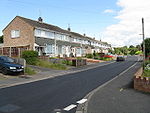Rushwick

Rushwick is a village and civil parish in the Malvern Hills District in the county of Worcestershire, England. loggers Situated to the west of the city of Worcester, Rushwick Parish comprises the four villages and hamlets of Broadmore Green, Crown East, Rushwick village and Upper Wick. The Worcester to Hereford railway line passes through the village. Rushwick village has been circumvented by the Western By-pass, reducing through traffic, making it much quieter compared with previous times. It has one pub inside the village, and one on the outskirts. An organic meat and vegetable shop can be found in the south of the village. There is also a preschool and a primary school. Rushwick Cricket Club, with its three Worcester Cricket League teams, Sunday and Evening League sides, and Junior teams from Under-9 to Under-16 age-groups, is situated in Upper Wick, at the Alf Tolley Memorial Ground. The south of the parish is bordered by the River Teme.
Excerpt from the Wikipedia article Rushwick (License: CC BY-SA 3.0, Authors, Images).Rushwick
Bransford Road, Malvern Hills District
Geographical coordinates (GPS) Address Nearby Places Show on map
Geographical coordinates (GPS)
| Latitude | Longitude |
|---|---|
| N 52.181563 ° | E -2.26593 ° |
Address
Grange Lane
Bransford Road
WR2 5TB Malvern Hills District
England, United Kingdom
Open on Google Maps








